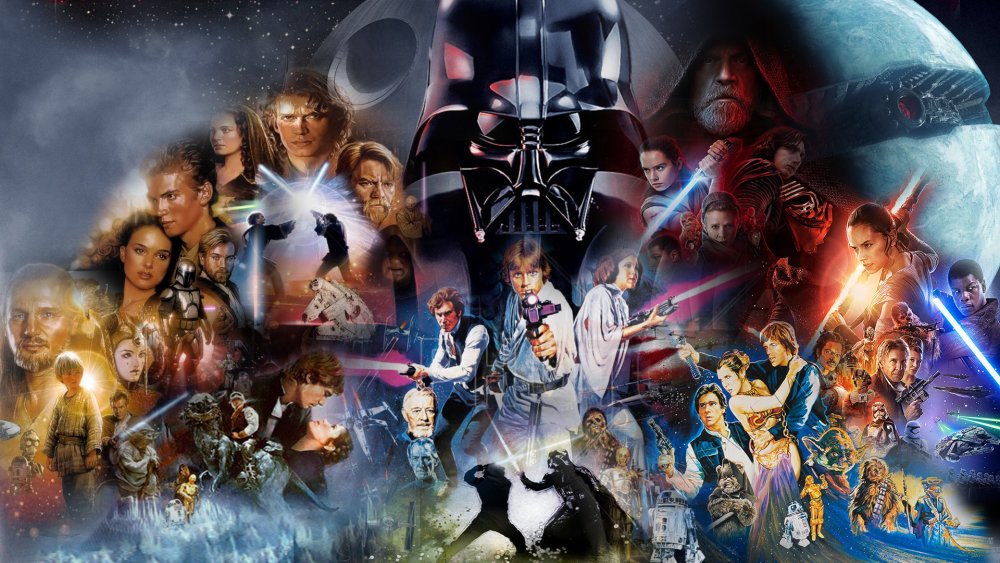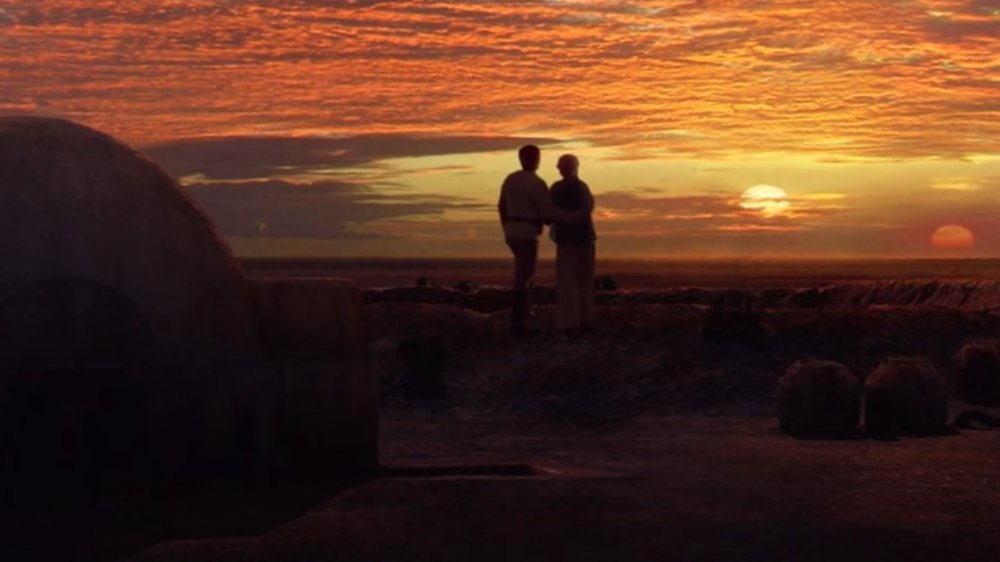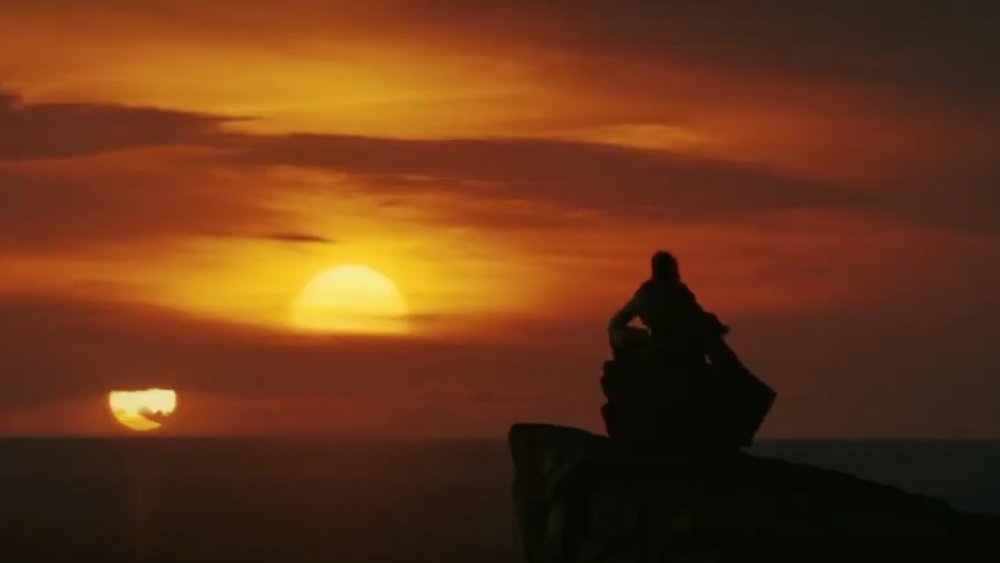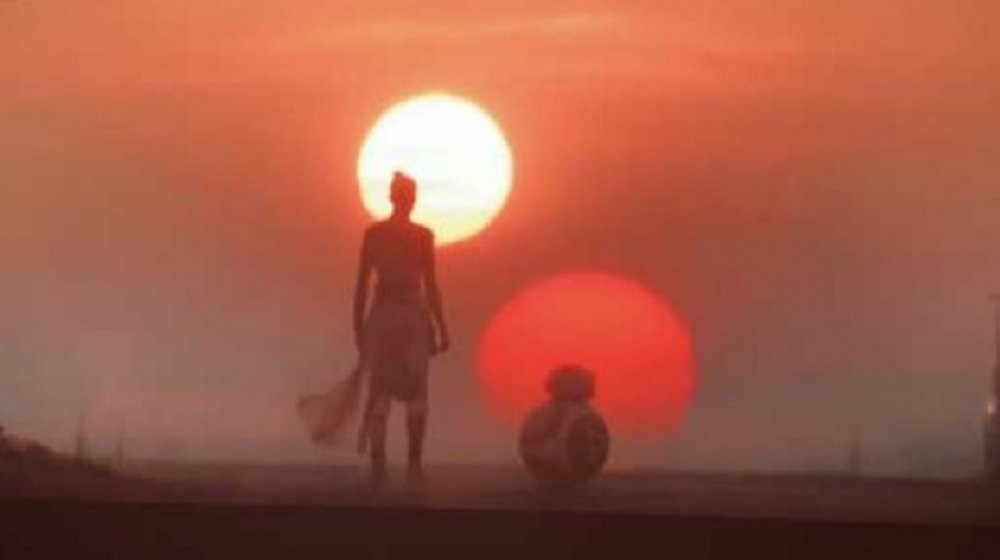The One Scene That Links All Of The Star Wars Trilogies Together
The Skywalker Saga stands as an unprecedented cinematic achievement: nine films, three trilogies, 42 years, and one epic struggle between the Light and the Dark. The series is the ultimate genre mashup, combining elements of fantasy and science fiction with a heavy dose of samurai pictures such as Akira Kurosawa's The Hidden Fortress, which was a direct inspiration on the first film — you know, the one that completely upended pop culture in 1977, helping to create the very idea of the summer blockbuster and giving rise to an entirely new breed of dedicated fandom.
Of course, there are themes that link each trilogy: the nature of family, whether we are bound by fate, and the meaning of sacrifice, to name a few. But as many fans know, the trilogies are also linked by something else: one particular shot, framed in a very specific manner, that appears at least once in each trilogy, four times in total. In three of these scenes, Luke Skywalker is present — and in the fourth and final one, he might as well be.
Let's take a look at the scenes that link each Star Wars trilogy — original, prequel and sequel — to each other. Please be advised that spoilers for Star Wars: The Rise of Skywalker follow.
Star Wars: A New Hope — Luke Skywalker ponders his future
We can call this the "Binary Sunset" shot, and its first appearance — near the beginning of Star Wars: A New Hope — is nothing short of iconic. In it, Luke — having just finished dinner with his Aunt Beru and Uncle Owen — ascends a small dune outside the family farmstead to gaze wistfully at Tatooine's twin suns as they set on the horizon. Luke has just been told by Owen that he won't be able to apply for early entrance to the Academy; he's needed too badly on the moisture farm, and even though most of his friends have long since departed, he'll have to stay behind for another whole year.
As Luke wordlessly regards Tatooine's sunset, John Williams' score swells on the soundtrack, giving us the sense that Luke won't have to wait for as long as he thinks. At the time of the movie's release, audiences were just fascinated by those twin suns, a unique and compelling visual signifier that this was all, indeed, taking place in a galaxy far, far away. More significantly, though, we were looking at a teenage Luke in the prime of his life, just on the cusp of becoming saddled with the revelation that he was far, far more important to the struggle gripping the galaxy than he had any right to think. The shot also occurred right near the start of the original trilogy, and when next it appeared, the circumstance was decidedly flipped — coming as it did at the very end of the prequel trilogy, and the very beginning of Luke's life.
Star Wars: Revenge of the Sith — The "Harry Potter" scene
The Binary Sunset shot next appeared as the final shot in Star Wars: Revenge of the Sith, wrapping up the so-called "Harry Potter scene" in which the infant Luke was delivered to Owen and Beru by Obi-Wan Kenobi. Audiences were far from the only ones to note the similarity to the iconic opening scene of the Harry Potter series; at the moment in Revenge of the Sith that Baby Luke is handed over, an eleven-note musical motif from Harry Potter and the Sorcerer's Stone (which was also scored by Williams) appears on the soundtrack. (We suppose Obi-Wan is a stand-in for Hagrid in this instance, although he arrives at the farmstead on a weird-looking camel-beast rather than a flying motorcycle.)
As Owen and Beru hold the youngster, they gaze out at that Tatooine sunset, pondering an uncertain future. It was an astute choice by director George Lucas (some would say one of too few he made during the production of the prequel trilogy) to give us this shot as little Luke is beginning his journey; it was an even more astute choice by Star Wars: The Last Jedi director Rian Johnson to reprise it once more as Luke's journey reaches its end.
Star Wars: The Last Jedi — Luke comes full circle
At the climax of The Last Jedi, the controversial middle film of the sequel trilogy, Luke allows the battered remnants of the Resistance to escape the surface of the planet Crait by engaging in a supremely devious bit of misdirection. Finally (apparently) deigning to leave his self-imposed exile on the planet Ahch-To, Luke suddenly appears in the middle of the fight, drawing the fire of the First Order forces... literally all of the fire, which somehow doesn't so much as singe his hair. He then takes on Kylo Ren one-on-one in a lightsaber duel, but as the Resistance fighters make good their escape, it becomes apparent to Kylo that something is very wrong.
That is, he actually hasn't been fighting Luke at all; the "last Jedi" is still right where he'd always been, on Ahch-To, generating a Force projection of himself as a distraction. The effort completely annihilates Luke, and as he prepares to become one with the Force, he looks out over the horizon of his adopted planet to see a familiar sight.
Yes, as he dies, Luke is basking in the glow of a Binary Sunset, marking the end of his life just as it marked the beginning and the middle. It was an amazing visual bookend, perhaps suggesting the duality that has always lived inside Luke — and for the final film of the saga that bears the Jedi's name, writer/director J.J. Abrams revisited it one last time.
Star Wars: The Rise of Skywalker — Rey Skywalker ponders her future
In the final scene of Star Wars: The Rise of Skywalker, Rey has defeated Emperor Palpatine with the assistance of Ben Solo, Leia Organa (both of whom gave their lives in the effort) and the spirits of Jedi past. Along with BB-8, she makes a pilgrimage to Tatooine, to a familiar location: the remains of the Lars farm, which Luke had found destroyed by Stormtroopers all the way back in the first film. She brings with her Luke and Leia's lightsabers, and — having constructed her own, one with a blade of yellow — she buries them in the sand outside the location where Luke was first tragically forced to embrace his destiny.
Asked her name by a local, Rey receives the silent approval of the Force ghosts of Luke and Leia before replying, "Rey Skywalker" — and then, just before the credits roll, she and BB-8 look out over that same amazing sunset that had announced to us 42 years prior that we were watching the beginning of something special.
Rise of Skywalker has proven to be divisive among critics and fans, but considering that it brought to a close a saga that many never wanted to end, this was to be expected. We're of the opinion that the flick's reputation and standing within the Star Wars franchise will only improve with time — and that one day soon, it'll be considered just as iconic as its final shot, one which links together three trilogies which have inspired fans to dream of worlds beyond our own for four decades.




